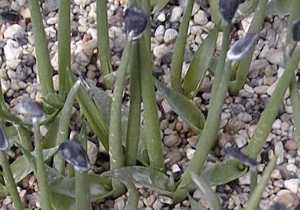Agave parryi

Common: Parry's agave, Parry's century plant, Mescal
Family: Agavaceae
Origin: Sonoran and Chihuahuan deserts from southeastern California to western Texas and south to northern Mexico
Light: Full sun, reflected heat, part shade
Soil: Tolerant of any soil conditions
Water: Drought resiliant
Compact accent plant that can be used as specimen or in a group, giving desert, tropical effect. Good xeriscape or container plant, mixing well with other desert species.
Slow growing to 2-3 feet high, 2-3 feet whie. Succulent, half hardy, rosette shape with rounded top. This agave has grayish green leaves, spatula shaped, with hooked spines on margins. Leaves are 20 inches long in large, basal rosette, and have shorter spines along edges.
After approximately 25 years, the plant shoots up a flowering stalk to 18 feet and can be up to four inches in diameter. Buds are reddish orange, turning yellow after opening. Flowers have 6 petal-like parts to 2-2-1/2 inches long, facing skyward in large flattened clusters. Blooms June to August. After blooming, this plant dies.
This plant is pollinated by insects and hummingbirds. The juice of this species can be irritating to the skin. Native Americans use plant for food, fiber, soap, beverages and medicines. Members of the Agave family, century plants take many years to flower, although not a century. There are twelve species of Agave in Arizona.